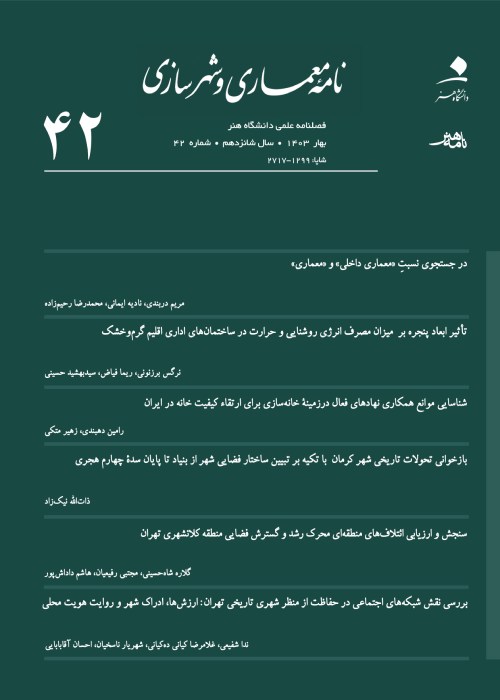Design principles of interior artifacts with purpose of reducing intervention in the context: Redefinition of temporary exhibition of contemporary artworks in historic buildings
Author(s):
Abstract:
Temporary exhibition of contemporary artworks in historic building, like any other interior projects, is a proportion between subject or artifact on display and the context of design. The important parameters in this proportion are: Limitation on intervention in the context, space restriction and relying on interior architecture elements. Organizing and presenting the artifacts in any kind of building are related to these factors directly. Specifically, in historic buildings, these aspects of works will be more important since the issue of intervention rate- in order to preserve and display the buildings values- will be added. Therefore, the goal in this article was considered to be providing design principles for the interior artifacts to reduce interventions in the context of design and its purpose was considered to be redefining the nature of the interior design artifacts in temporary exhibition of contemporary artworks in historic buildings. So, the articles main question was stated as following: how can we provide the temporary exhibition of contemporary artifacts relying on capabilities of design artifacts with lower intervention in historic building? The answer of this question was conducted in three stages as following:In first section, in order to determine the characteristics of existing artifacts, the existing concepts and methods in similar cases, were analyzed. This work was done among four buildings (Tehran Museum of Contemporary Art, Iranian Artists House, Iran Glass and Ceramic Museum and Moghadams House/ Museum) as representatives of various types of work in the interior spaces. In this section, the effort was based on having the conceptual models of each representative.
In second section, in order to find the nature of design artifacts, the objectives and affordances of artifacts in the exhibition, based on an abstract model of the artifacts affordances, were surveyed. In this regard, the Geros commands were referred in conceptual foundations of design. Therefore, we could define the abstract model of the artifacts nature.
The third section was allocated to describe architecture and redefining the artifact in order to construct these artifacts and convert their abstract model into objectively model, in constructions concepts. In this regard, the Ulrichs commands referred in production processes. Finally, the combination of modular architecture and integrated design was redefined to these artifacts and Features of configuration process and their components were determined.
Finally, based on the outcome of these three stages, the artifacts were proposed when displaying artifacts instead of intervention in context, with their adaptive nature, will keep the values in historic building. On this basis a redefinition of design were obtained in temporary exhibition of contemporary artifacts in historic building.
In second section, in order to find the nature of design artifacts, the objectives and affordances of artifacts in the exhibition, based on an abstract model of the artifacts affordances, were surveyed. In this regard, the Geros commands were referred in conceptual foundations of design. Therefore, we could define the abstract model of the artifacts nature.
The third section was allocated to describe architecture and redefining the artifact in order to construct these artifacts and convert their abstract model into objectively model, in constructions concepts. In this regard, the Ulrichs commands referred in production processes. Finally, the combination of modular architecture and integrated design was redefined to these artifacts and Features of configuration process and their components were determined.
Finally, based on the outcome of these three stages, the artifacts were proposed when displaying artifacts instead of intervention in context, with their adaptive nature, will keep the values in historic building. On this basis a redefinition of design were obtained in temporary exhibition of contemporary artifacts in historic building.
Keywords:
Language:
Persian
Published:
Journal of Architecture and Urban Planning, Volume:8 Issue: 16, 2016
Pages:
123 to 146
magiran.com/p1556107
دانلود و مطالعه متن این مقاله با یکی از روشهای زیر امکان پذیر است:
اشتراک شخصی
با عضویت و پرداخت آنلاین حق اشتراک یکساله به مبلغ 1,390,000ريال میتوانید 70 عنوان مطلب دانلود کنید!
اشتراک سازمانی
به کتابخانه دانشگاه یا محل کار خود پیشنهاد کنید تا اشتراک سازمانی این پایگاه را برای دسترسی نامحدود همه کاربران به متن مطالب تهیه نمایند!
توجه!
- حق عضویت دریافتی صرف حمایت از نشریات عضو و نگهداری، تکمیل و توسعه مگیران میشود.
- پرداخت حق اشتراک و دانلود مقالات اجازه بازنشر آن در سایر رسانههای چاپی و دیجیتال را به کاربر نمیدهد.
In order to view content subscription is required
Personal subscription
Subscribe magiran.com for 70 € euros via PayPal and download 70 articles during a year.
Organization subscription
Please contact us to subscribe your university or library for unlimited access!


